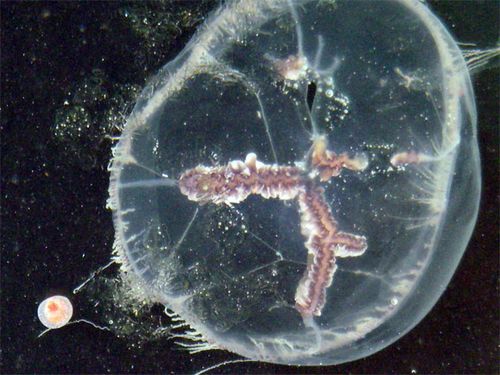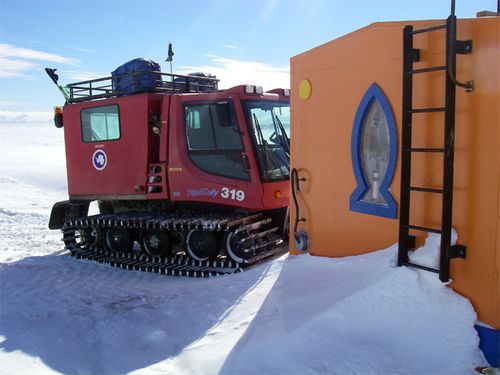Diving under the sea ice in Antarctica. What an amazing thought. Since I am not a scuba diver this would not be something I could do myself, BUT I could get close.
I had the wonderful opportunity to join Stacy Kim and her team as a dive tender. You can read all about Stacy's project here in Antarctica in polartrec teacher Michele Cross' journals with the Antarctica Undersea ROV ‘09 project. They do work with a remote controlled sub called SCINI
First of all let me introduce the three divers that I joined.
 Researcher on the Antarctica Undersea ROV '09 project
Researcher on the Antarctica Undersea ROV '09 project
 Part of the diving team
Part of the diving team
 Part of the diving team
Part of the diving team
All three of them live in California and have dived in many places around the world. They are all members of the same research team. Rachel Javorsek, an employee of Raytheon Polar Services and I were brought along as the dive tenders for the day. Dive tenders are the extra hands and the safety members of the team. Stacy, Francois and Isabelle have to bundle themselves into layers of gear which will keep them warm in the cold. While in the freezing water
 Another view of all the clothing each member must put on.
Another view of all the clothing each member must put on.
 Checking out your diving equipment is a vital part of preparations
Checking out your diving equipment is a vital part of preparations
 Isabelle puts on layers of insulating clothing and then the diving suit.
Isabelle puts on layers of insulating clothing and then the diving suit.
This is where the dive tenders become helpful. It is very difficult to have this much clothing on and try to zip zippers and pull on gloves and tuck in material around the neck and hands.
Heavy diving belts are then added for weight so they don't have to fight to keep their bodies from wanting to float to the surface. The air tanks also are place on their back and we help them attach these as well.
 Attaching all the air tubes before putting on gloves
Attaching all the air tubes before putting on gloves
 Geared up and ready to go
Geared up and ready to go
Then they are gone. Down a tunnel of ice that has been melted through the frozen sea ice.
 The splash is all that is left.
The splash is all that is left.
Bubbles, from their exhaling continue to bubble up through the whole for about 15 minutes until they have swam far enough away from the hole that the air can't find the way out. They will be gone between 30 and 45 minutes. Rachel and I have been trained to utilize the emergency radios to call for help if need be. Safety is the number one factor for any science team here in Antarctica. After the team disappeared I took pictures of the invertebrates that were swimming in thewater. Take the pictures and see if you can research what they are?
 Floating wonders...can you find out what they are?
Floating wonders...can you find out what they are?
 This one is the size of your palm...but don't touch it!
This one is the size of your palm...but don't touch it!
 The forms of life living here are beautiful. These creatures are smaller than a dime
The forms of life living here are beautiful. These creatures are smaller than a dime
 Even in these cold temperatures life thrives
Even in these cold temperatures life thrives
 You see the ladder the members will use to get out of the water but look for the life forms swimming
You see the ladder the members will use to get out of the water but look for the life forms swimming
Check out Michele Cross' journals on polartrec for the answers. She has loads of great pictures of their project and you will find them in her journals.
http://www.polartrec.com/antarctic-undersea-rov-09
The dive hole itself is located inside a fish hut. There is a trap door in the floor that gets opened up to reveal the hole. While Rachel and I waited I took this time to interview her. Rachel's story, like so many down here, is an interesting one and she has had unique experiences. Give a listen.
http://
The fish hut was sitting on frozen sea ice that was 3-5 meters thick between the base of Mt Erebus and an island called Little Razor Back. The views were stunning, and there were many Weddell seals sunning themselves in the area.
 Our Piston Bully parked outside the fish hut.
Our Piston Bully parked outside the fish hut.
 See the fish hut near Little Razorback Island.
See the fish hut near Little Razorback Island.
 Nursing time for the little one
Nursing time for the little one
 As far as you can see is frozen sea ice.
As far as you can see is frozen sea ice.
40 minutes after they had disappeared through the ice-hole they were back. We knew they were returning because the bubbles started rising up and churning the water. One by one they slowly rose allowing their bodies to adjust to the change in pressure. Once they reached the surface Rachel and I had our jobs to do. Grab items they handed to us, pull out heavy tanks and belts, and assist in unzipping gear. Fortunately the hut has a heater because even with all the gear they had dawned to keep themselves warm they were cold. After packing all our gear back into the little piston bully we took time to photograph the area. Before the 90 minute ride back to McMurdo. The piston bully is like riding on an old John Deere tractor going crossways over a plowed field. Believe it or not three of us went to sleep in the back seat bouncing around loose groceries in the back end of a truck. But what a day!!
 I hope I am conveying the majesty of this unique place on our planet. It is truly awe inspiring.
I hope I am conveying the majesty of this unique place on our planet. It is truly awe inspiring.
To the team of SCINI thanks for the "SPLASHING" good time!
Trekkers, New Friends = New Adventures Mr. W

